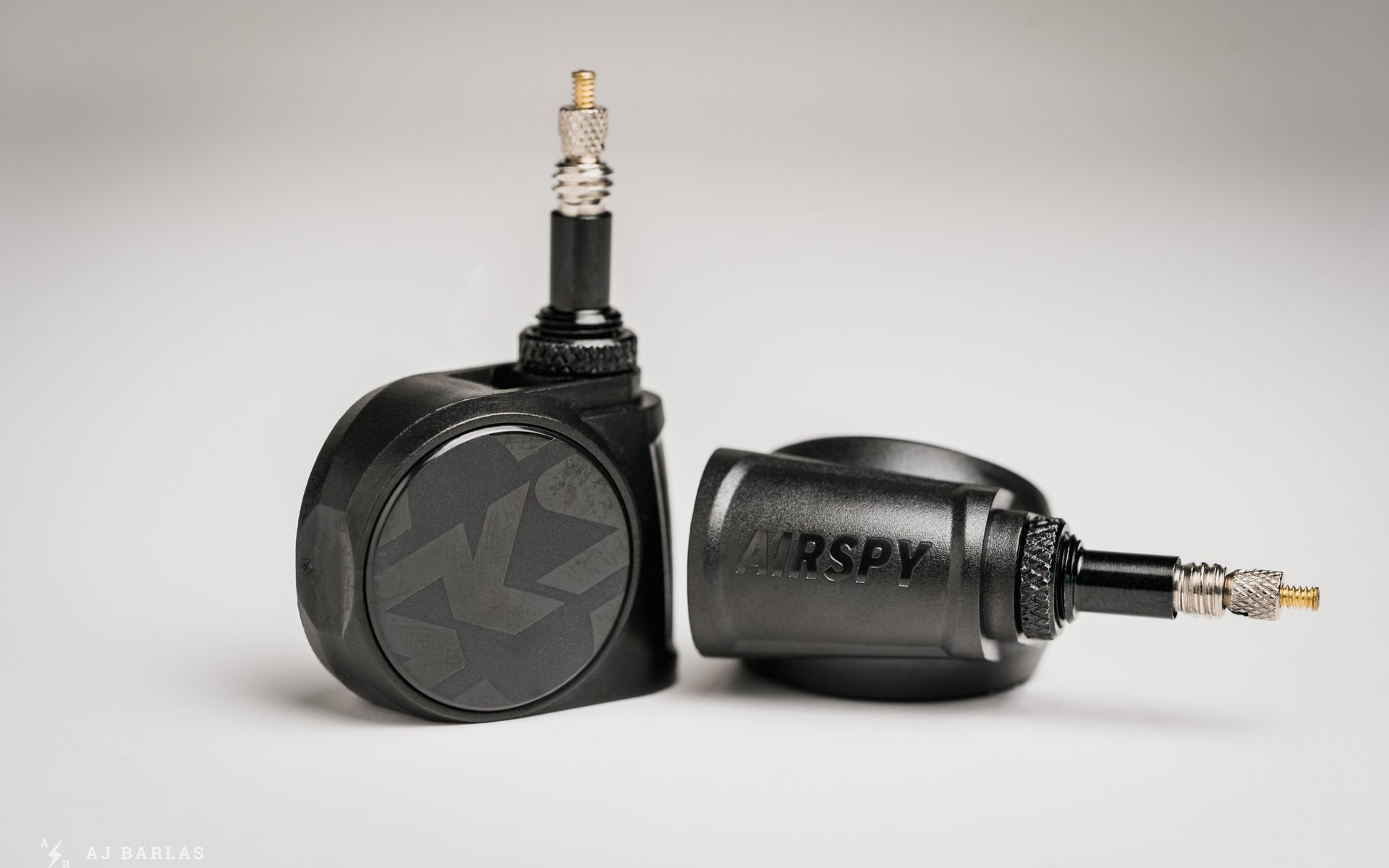
Geekbench, eat your heart out
SKS Airspy Review
Late last year I found myself trying to simplify my pre-ride ritual. I’d recently returned to coil-sprung suspension and was excited about the faster ride preparation that resulted. If only my tires were coil-sprung! I never used to check my pressures before every ride but as the years have flown by I’ve found myself more consistently recording and checking. My O.C.D. can be pretty strung out at times but I swear it isn't solely to blame here. I'm trying to remove variables that can influence my experience with a product but I dislike how much time it sucks. And that's where the Airspy comes in.
A slightly low rear tire can modify the shape of the bike, changing how it reacts on the trail. An under-inflated front tire can cause a serious accident but before getting there can have an adverse effect on steering. Slight deviations can go unnoticed and result in riders questioning setup after encountering strange characteristics on the trail. Our tires are the first point of contact with the terrain and have an immense effect on the quality of our ride. I stumbled across the Airspy and thought the system might remedy some of these impacts while getting me out of the garage and onto my bike in less time. The Airspy is similar to the original Quarq TyreWiz but not as sleek as the updated version. I was hopeful this bit of tech geekery would allow me to completely forego the pre-ride pressure gauge dance.
Highlights
- Options to fit Schrader or Presta valves
- Operates with a CR 2032 battery (included)
- Max pressure of 120psi (8.3 bar)
- Data read to a smartphone app or compatible Garmin Device
- Data transmission via Bluetooth or ANT+
- It can suggest a tire pressure based on information provided
- Reads tire pressure within +/- 1% of the measured value
- 15% “Deviation” from set pressure
- A 25% deviation or higher issues a warning and red tyre in the app
- Includes four “U-lock” sizes to secure the unit to the spoke
- Dustproof and watertight according to protection class IP67
- Weight: 18g
- MSRP: 144.99 USD / 99.99 EUR (set of two)
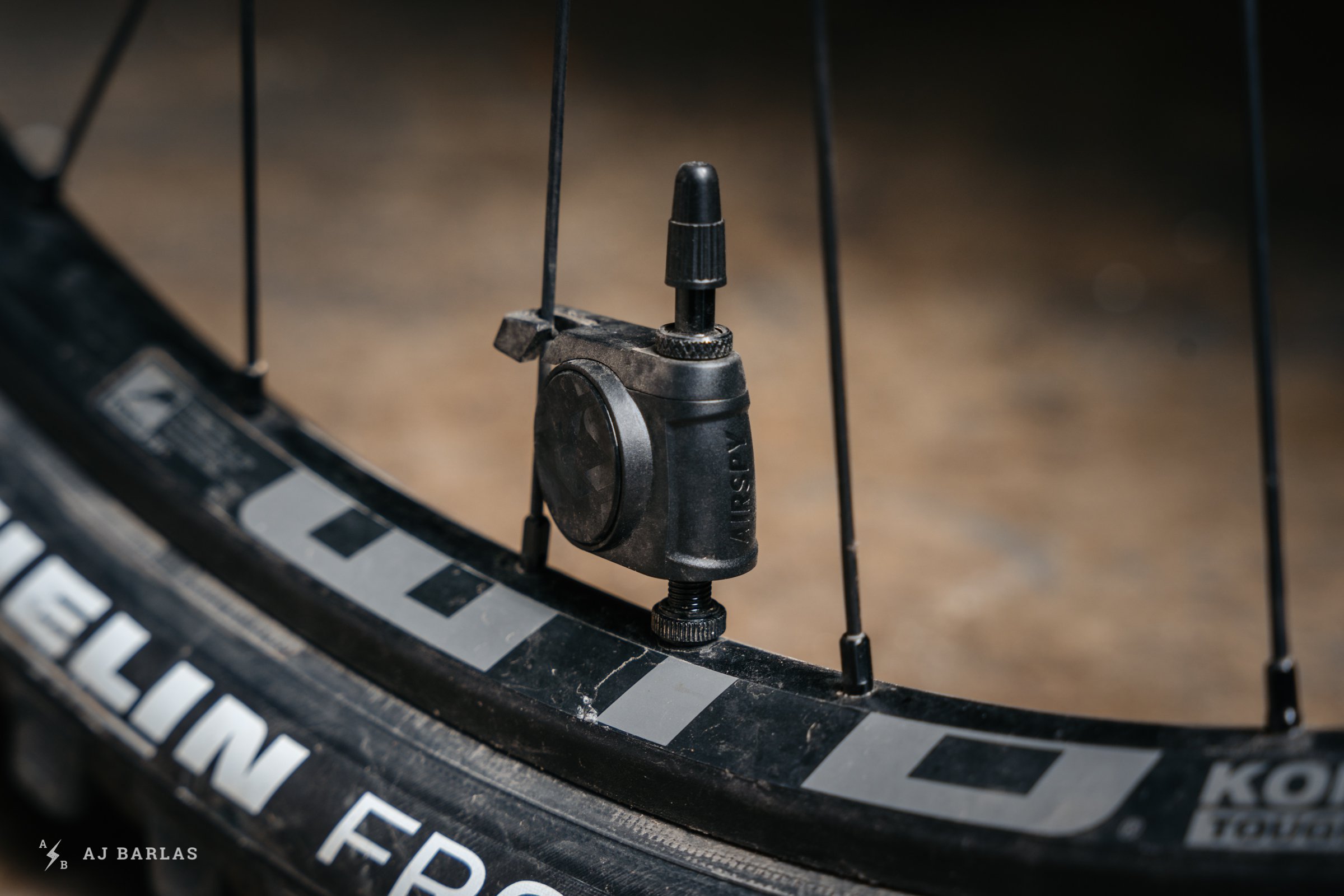
The Airspy won't go completely unnoticed, but it's still relatively small for it's capabilities.
SKS Airspy Technology
The manual made setting up the Airspy relatively straight forward. Installation and setup of the app were also simple and intuitive. The SKS My Bike app is free and can be downloaded to either an iOS or Android device. In addition to the Airspy functionality, the app also provides a place to track your rides, navigation, and what SKS call Bicycle Pass, which provides somewhere to store information on your bike that may be needed if it were stolen.
The Airspy can also be connected with compatible Garmin devices by downloading and installing the Airspy app from the Garmin Connect IQ store. Unfortunately, my early model vívoactive watch predates the compatible devices but it's possible to use the Airpsy app on other watches or the more traditional Edge cycling computers. It would be interesting on the trail but in reality, a quick check on the phone was easy enough.
When not in use, the Airspy goes to sleep and won't transmit data between devices. A short jiggle or spin of the wheels awakens it, beginning transmission and when opening the My Bike app, the data is promptly shown on the screen. When setting up the app, the desired pressures are recorded and you can run multiple tire or bike setups. If pressures are out by more than 15%, the wheels on the bike in the app turn yellow and if they’re out greater than 25%, they’ll turn red.
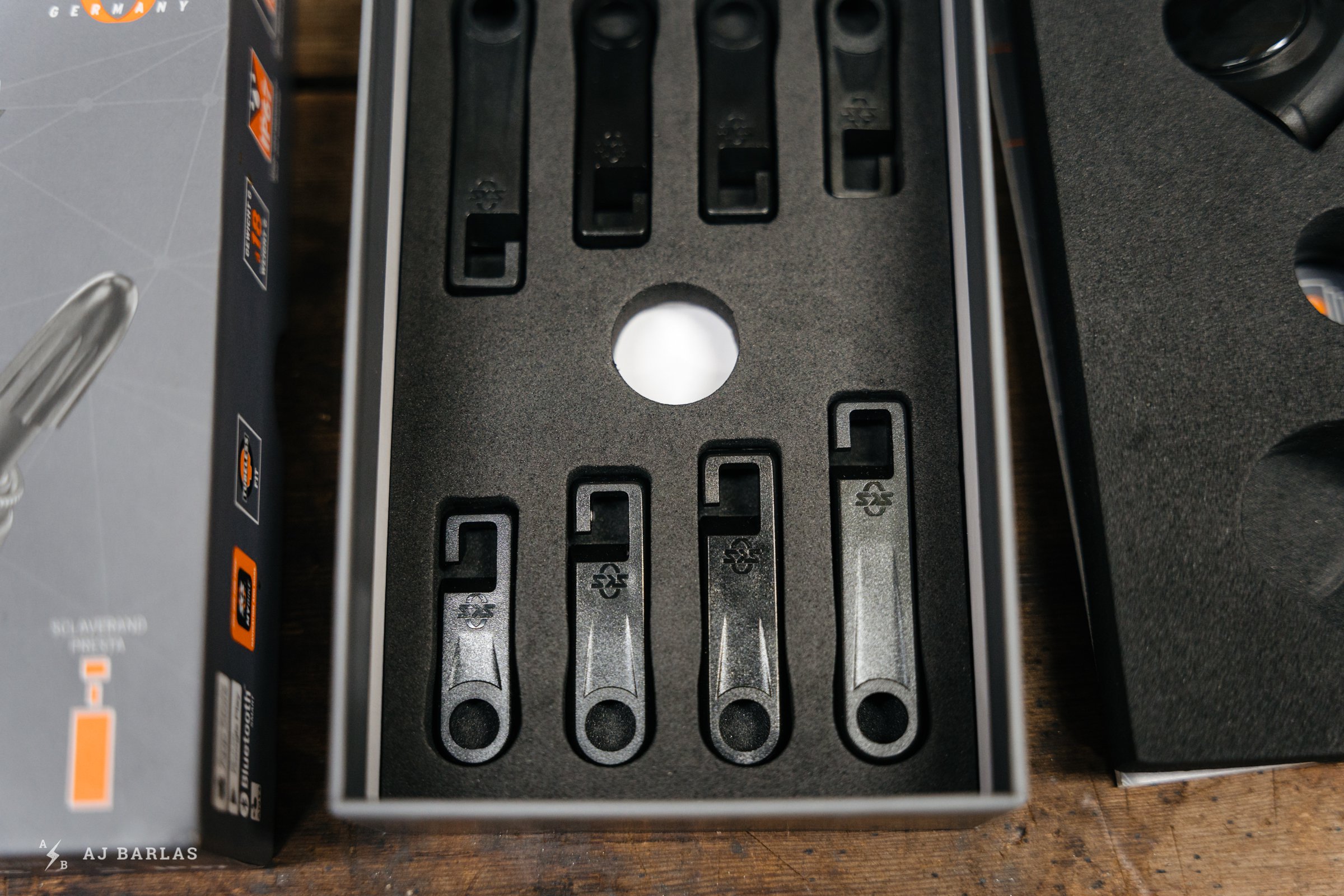
The four provided "u-locks" that come with the Airspy. They're locked in place to the top of the device with a second valve nut.
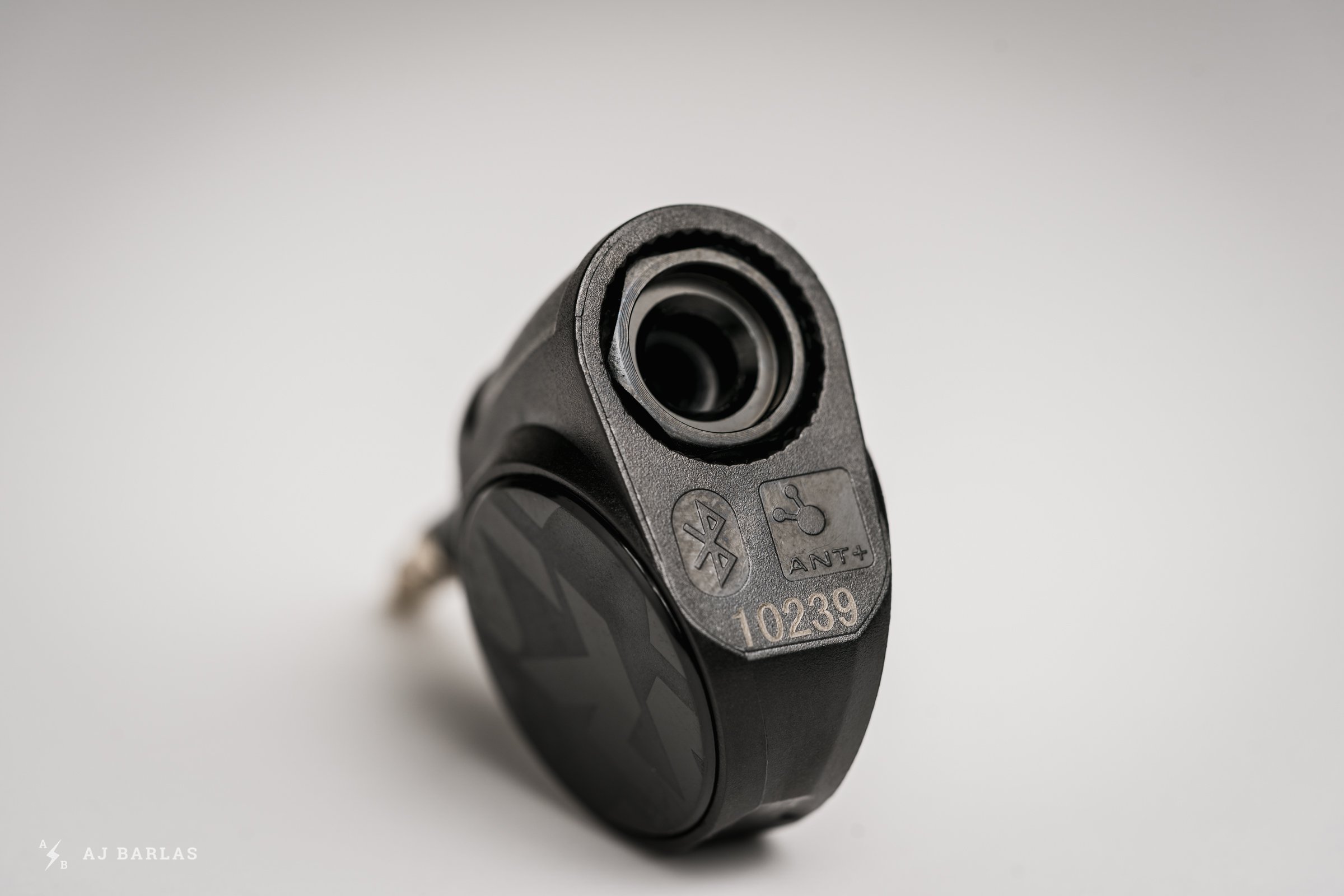
The device threads over the existing valve, making it possible to use with Cushcore or other inserts that require a special valve.
With a claimed pressure accuracy of +/- 1%, the SKS Airspy is likely more accurate than any of us require. I tried to check the readings against the digital pressure gauge I’ve been using for years, a first gen. SKS Airchecker, but I was unable to get a reading with the Airspy in place.
Mounting the Airspy sensor to the wheels was easy but I followed the directions to the letter. In hindsight, it's simple enough to stumble through without guidance but I wanted to make sure everything was set up as expected. Anyone who’s removed their valve core can complete the install and the Airspy sensor simply threads onto the valve stem once the core is removed. A minimum of 15mm needs to be available for the sensor to mount correctly. After that, selecting the correct u-lock from the four different sizes provided secures the sensor to a nearby spoke.
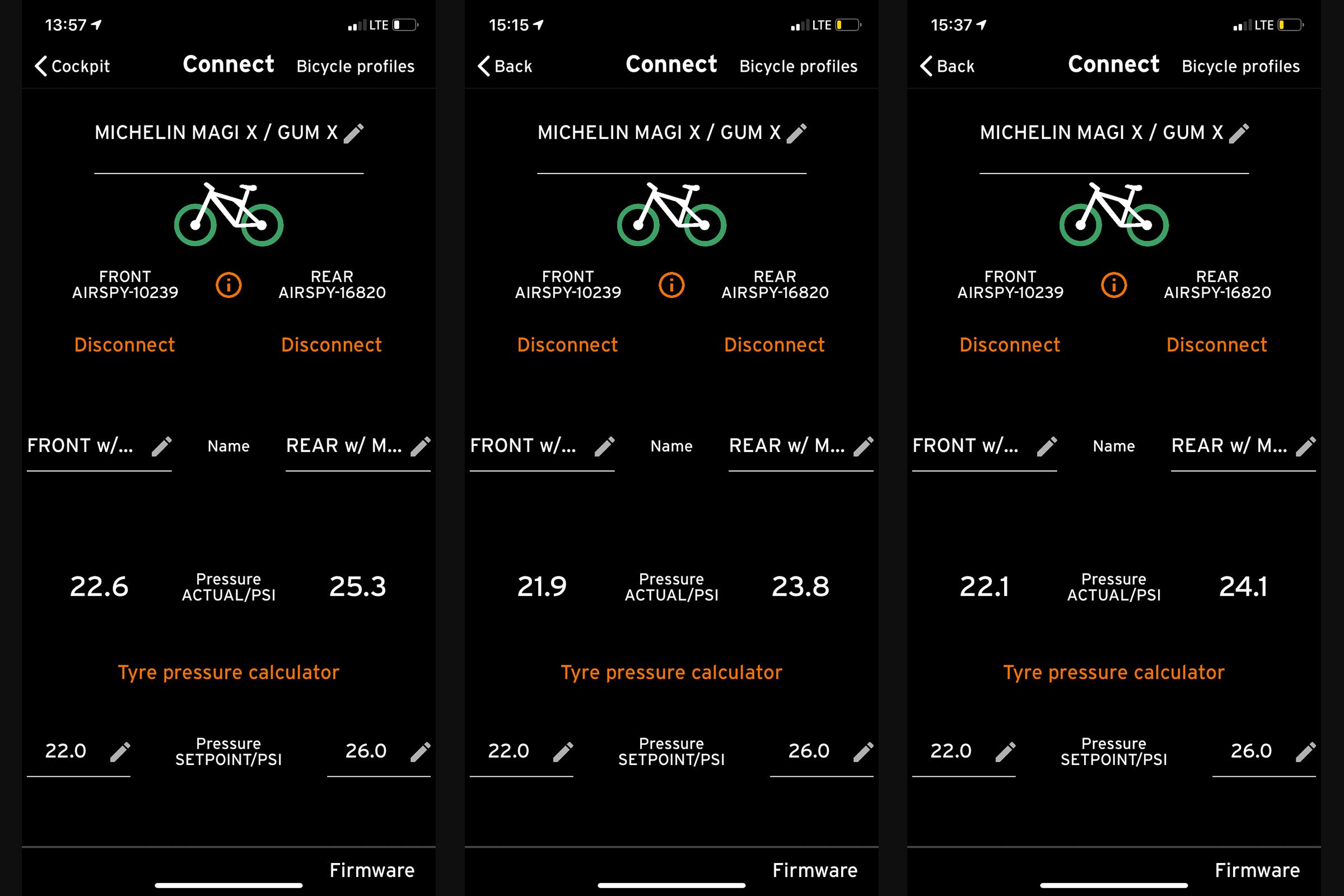
The data shown on the phone. Green wheels on the bike indicate pressures are within the 15% deviation range of the Airspy. I was running low of sealant on this ride and my rear tire pressure slowly dropped by the top (center). After the first long-ish decent pressures bumped up a few psi (right).
Pre-Ride Dance Simplified?
The most interesting element of Airspy was monitoring how pressures change during an average ride. I don't normally check pressures out on a ride but, when in Rome... Setting pressures to my preference before the ride, I found things had changed by the time I reached the top. In hot weather, I found my pressures could jump 2–3psi when I was dropping in. Sitting in the sun for a chinwag would result in the largest pressure changes. Other times, issues with slow leaks – thanks to a lack of sealant – would show themselves. This data can be associated with the ride in Garmin Connect and when I update my device I'll go more in-depth on this.
It’s not often that pressures need adjusting on a ride but being able to quickly make changes while monitoring on the phone or Garmin proved beneficial. While riding, the Airspy goes relatively unnoticed but there were occasions where the u-locks rattled against my spokes and I found that over time, they would cause the valve stem fastener to come loose. This increased rattling to the extent of sounding like I'd installed spokey-dokes, but some rubber mastic tape inside the hook reduced the noise.
Back in the garage, Airpsy didn't actually simplify my pre-ride ritual. For every day that my bike sat, it lost ~1psi in pressure from each tire, which required attention to keep things consistent. That change means that even with a tighter tolerance to pressure deviations I'd still need to reach for the pump. I’ll test the Airspy on future wheels when I suspect they’re doing a better job of holding pressure. Airing up in all situations was simplified thanks to the live data displayed in the great resolution of a modern-day smartphone screen. With the app open and monitoring as air is pumped, it’s easier to stop close to or even at the desired pressure, often requiring no adjustments once the pump was removed.
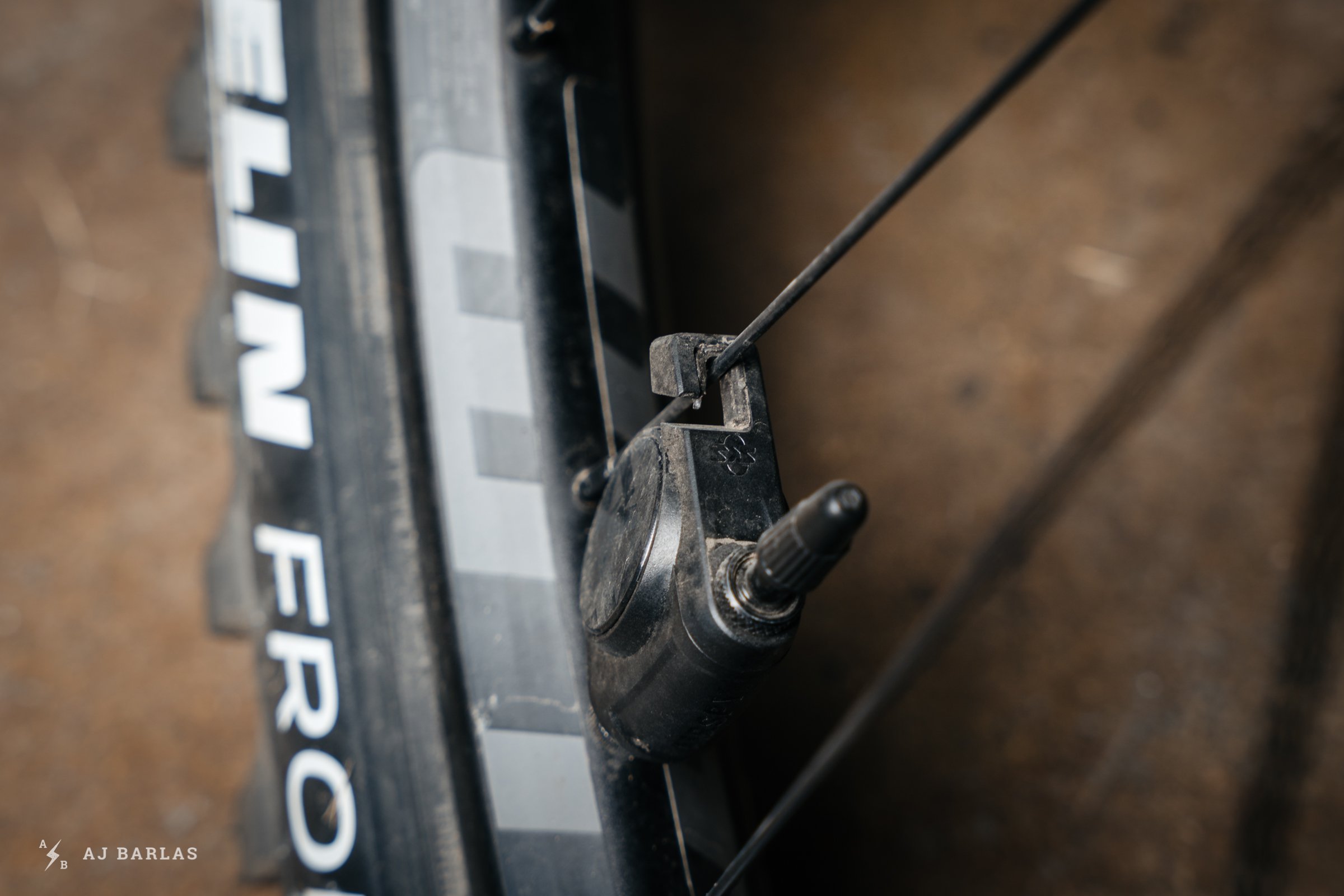
The u-locks rattle against the spoke but a small piece of rubber mastic tape quietened things down.
Areas for Improvement
Ideally, I wouldn’t need to open an app or look at a Garmin device to know if pressure is off. The Airspy doesn't notify riders of tire pressure at a glance, while TyreWiz does this with a red or green light. I also found the Airspy’s room for deviation too much and even at my relatively low pressures, a 15% variation could mean a green light despite my tires going from the preferred at time of testing 22psi/25–26psi (f/r) to less than 19psi/22psi. If I were to drop my tire pressures that low I'd lose the ability to push the bike how and where I want, and run the risk of blowing a bead or worse.
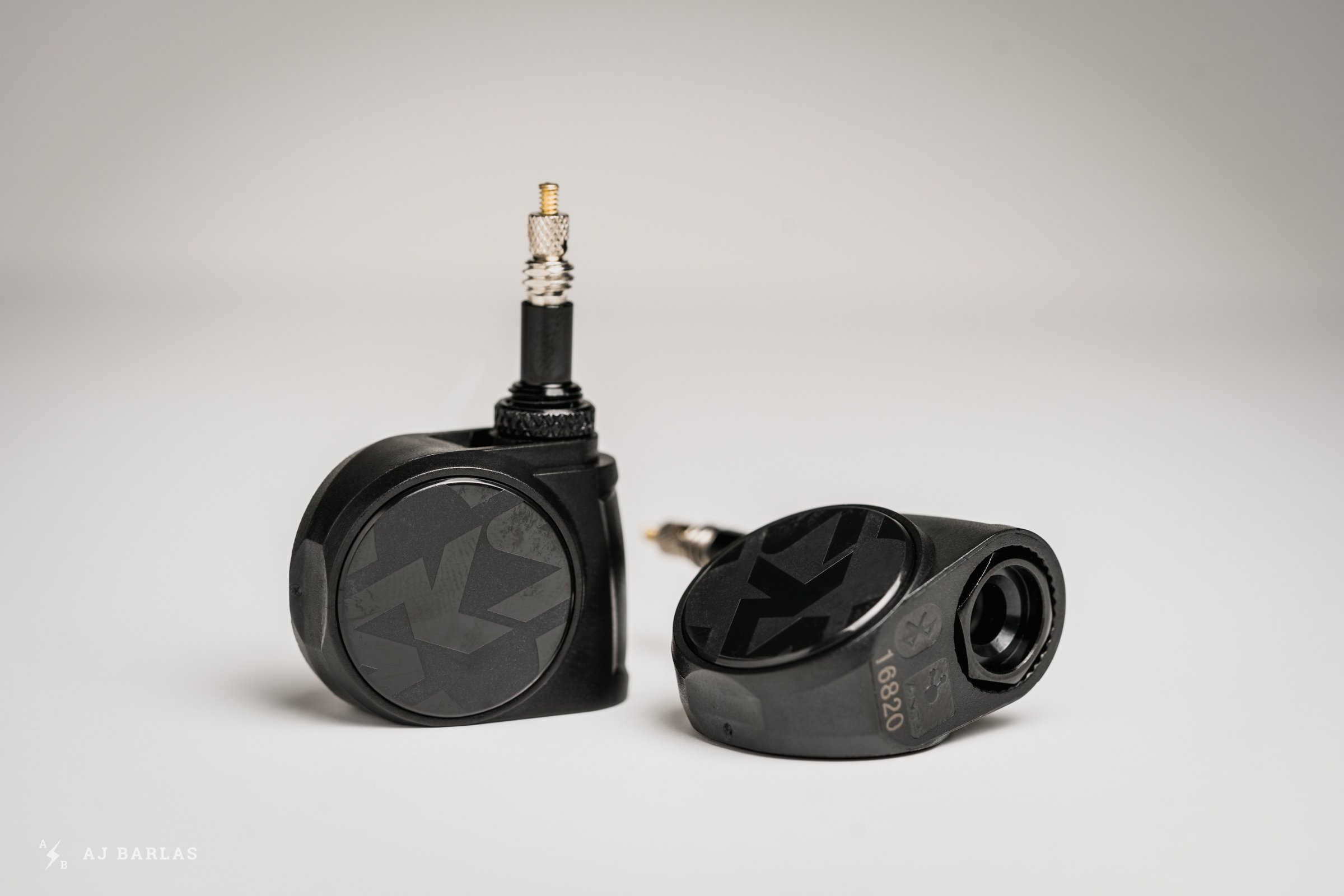
The Airspy is an interesting device but it isn't for riders using the finger-pressure check or who are happy with their pressure gauge.
Conclusions
Where the Airspy shows promise is its ability to translate real-time data and send an alert to your phone or Garmin device if things get (greatly) out of whack and pressure checks can be completed without even touching the valve. I didn’t have an issue on the trail but something like a small puncture has the potential to cause larger problems, which this could prevent before something worse happens. That's if SKS can tighten the room for variation to within 1psi – which the TyreWiz is capable of. Using the live feed to see pressures as the tires are adjusted is great, making trailside changes more accurate – that is if you don’t carry a pressure gauge on rides. Plus-size and even more-so, fat bike tires could benefit from the incredible 0.1psi readings as well.
At a lower cost than similar devices, the Airspy positions itself well for curious riders turned away by the 200 USD competition. But those savings come at the cost of deviation and a need to check status using a screen. It’s certainly not going to be something everyone needs but for riders who appreciate data, ditching the traditional gauge, or real-time tire pressures will be happy with what SKS offers with the Airspy. For me, it appears the only way to further simplify my pre-ride ritual involves solid rubber tires…
More information on the SKS Airspy is available on their website.
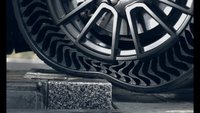
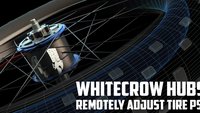








Comments
Vik Banerjee
3 years, 6 months ago
I've simplified and improved my pre-ride process by getting one of these mechanical pressure gauges.
1. Add some air to tires. [Assuming it's been a few days since the last ride]
2. Check pressure and use gauge's air release button to lower to correct pressure.
3. Ride.
The gauge is cheap and I can let air out without removing it so getting to the correct pressure is painless. I have a 0-30psi model for my "normal" tire bikes and a 0-15psi model for my plus bikes. No batteries or other tech to deal with.
Reply
AJ Barlas
3 years, 6 months ago
Hahaha. Yeah, I’ll be looking at returning to my trusty SKS digital gauge. It too can make the adjustments without removing it. To be clear, I was really hoping to be able to check the app for the current pressure and see everything was fine, removing a need to do anything at the wheel. Unfortunately my (possibly all?) wheels/tires don’t seal well enough for that luxury.
Reply
Chad K
3 years, 6 months ago
I definitely fall in the camp of riders who religiously check their tire pressure before each ride. I have a few of the Topeak digital gauges so that I can keep one in my garage, one in my car, and third in case I ever have the need to carry one on a ride. Excessive? Maybe, but at least I never have to think about where I put my tire pressure gauge.
Reply
fartymarty
3 years, 6 months ago
I'm with you on checking pressure before every ride. I usually lose 1-2 psi per day so they always need topping up. SKS airchecker is my go to with 0.1 psi accuracy.
Maybe the secret is to put a few extra psi in post ride so you only have to deflate pre ride. Saves checking and pumping pre ride.
Reply
Pete Roggeman
3 years, 6 months ago
In fairness, I suppose better sealing wheel/tire combos might change that. Maybe the real benefit of this unit, then, is the ability to check pressure in the middle of a ride that has a lot of aggressive riding, or altitude or temperature changes. Ditto for bike park days.
Reply
Dustin Meyer
3 years, 6 months ago
I've got the 0-15 and the 0-30. I want to like them, but my issue with these is that if you drop it once, its likely ruined, but there's no way to tell unless you check it with a known accurate gauge.
Last winter my 0-15 was reading 1.5psi while the brand new 0-30 was reading closer to 4 psi.
At this point, my thumb is more trustworthy than either gauge.
Reply
Pete Roggeman
3 years, 6 months ago
It isn't ruined. You just need to recalibrate, and it's not that hard! Check this:
https://www.youtube.com/watch?v=h-7h652uGhg
Reply
grimwood
3 years, 6 months ago
Thanks Pete! Super useful! And those cheap Accugauges really don’t like being dropped...
Reply
IslandLife
3 years, 6 months ago
Shit... I really wish I didn't now know that pressures changed so much during a ride... thanks a lot.
Sincerely,
Your fellow OCD anal bike nerd.
Reply
mrbrett
3 years, 6 months ago
Add some elevation changes to the temperature changes, and you're playing Pressure Roulette!
Reply
Cr4w
3 years, 6 months ago
I'm totally into a product like this but not having a little light on them is a huge miss. Being able to glance at them to see if they're green (within range) or red (needing air) would be amazing.
Reply
Pete Roggeman
3 years, 6 months ago
Bonus for nighttime bling!
Reply
Sean Chee
3 years, 6 months ago
I should froth hard on this as data analytics is a key part of my day job (I run a network of close to 300 sensor nodes) but being stuck with their deviation definition is a big turn off to me. 15% is way too much.
Reply
AJ Barlas
3 years, 6 months ago
It is quite a bit hey. I struggle to think who would be fine with such a variable?
Reply
Sean Chee
3 years, 6 months ago
It really wouldn't be hard for their apps to allow users to set their own thresholds. Even if it is part of the sender units firmware they would likely have a way to update them ota.
I can imagine these being useful for touring across mixed surfaces in which case 15% is an even less suitable range.
Reply
Mikey Bikey
3 years, 6 months ago
https://www.amazon.com/Makita-DMP180ZX-Lithium-Ion-Cordless-Inflator/dp/B085DV34VC
Bought one of these for work, but it does bike tires just fine.
Milwaukee makes one also.
Turn it on, connect it to the valve, it tells you what you got. Tap the plus or minus button for pressure you want, pull the trigger and it shuts off automatically when you get there.
Reply
Pete Roggeman
3 years, 6 months ago
Is it powerful enough to seat a tubeless tire? I've been lusting after the Dewalt version. The Makita you linked is $300 in Canada but that includes the battery which is likely at least a $100 premium. The bare Dewalt version is about 170 w/o battery. Spendy vs a corded unit but being able to take it for off road use as well as camping makes it more useful.
Reply
Mikey Bikey
3 years, 6 months ago
Good question re. tubeless. I am not sure. I'll try and find out when I get some time Fri or Sat.
As far as batteries go, I got plenty of Makita for work which means there's always one that is charged up and which is also why I didn't buy the Milwaukee 12 amp version, which would be a one of for me.
Reply
kain0m
3 years, 6 months ago
I've seen the Makita pump used to re-seat 33" offroad car tires, so I'd guess yes. But then again, I always have a pressure bottle on hand for seating stubborn bike tires, so I am fine with a floor pump.
Reply
Sean Chee
3 years, 6 months ago
I second this style of inflator. I have one from my cordless vendor (ozito/einhell) and find it invaluable around the farm.
So easy to use and move around the place. I used it a couple of days ago to inflate a utv tyre so I could limp back to the vehicle workshop.
I also have a couple of Longacre gauges (ex a motorsport team) for Schrader valves and they're great. I'm not sure if you can get presta adapters for them because this inflator does the job so well.
Reply
Mikey Bikey
3 years, 6 months ago
Re. presta, the Makita has a schrader adapter which I already use on my tires anyway.
Reply
Mikey Bikey
3 years, 6 months ago
This comment has been removed.
Brigham_Rupp
3 years, 6 months ago
Am I crazy thinking that after 30 years of riding bikes, a good pinch with my fingers is sufficient for checking tire pressure? Have I been missing out on significant performance advantages by not sticking to carefully determined, exact pressures? Thanks to the nature of tubeless, I expect I’ll always have to add air, I always do, and I always fill to the same pressure on the iffy gauge of my Park pump. Doesn’t really matter how accurate the gauge is as long as it’s consistent. I’d pay 150 bucks if this thing maintained my pressure, not just indicated it.
Reply
Mikey Bikey
3 years, 6 months ago
Well, I used to go that route until somebody I was riding with lent me his gauge and I found out I was at 15 lb. and this was way before before tubeless/cushcore. No wonder performance was so lame and I was always getting snake bites.
IOW some of us need all the help we can get.
Reply
kain0m
3 years, 6 months ago
If you have a feel for it, of course, this is plenty fine. I'd hazard to guess it is more accurate than the +-15% Range of this Gizmo. Just don't expect single PSI accuracy...
Reply
Skooks
3 years, 6 months ago
I added a good quality pressure gauge to my floor pump. Makes it fast and easy to top up tire pressures before a ride. No need for a seperate pressure gauge.
Also, how long before these get plugged with sealant?
Reply
Sean Chee
3 years, 6 months ago
It shouldn't matter. Pressure sensors of this nature will work fine even if they have dried latex on them. I have one with duct tape covering it and it still reads true.
Reply
Dustin Meyer
3 years, 6 months ago
This is why the SKS is so much better than the Accu-gage.
Reply
AJ Barlas
3 years, 6 months ago
Good point. I've had issues with readings thanks to semi-clogged valves.
Reply
Kenny
3 years, 6 months ago
It doesn't seem to get great reviews but I've got the topeak shuttle gauge basically permanently attached to my floor pump and it saves a ton of time.
I know my tires lose a little air each day so I don't need a warning device to tell me they need air I just need a quick/instant way to know they back at spec as I pump.
I plug the head on, pump, the gauge reads in real time, I keep pumping till it reads good and ride. Perfect.
Reply
Please log in to leave a comment.